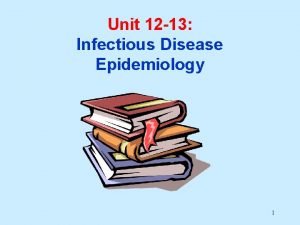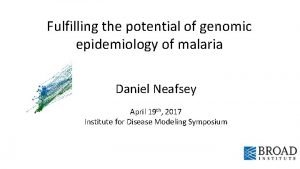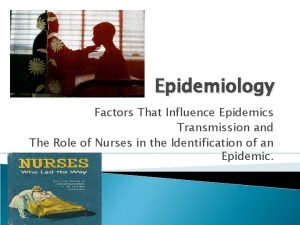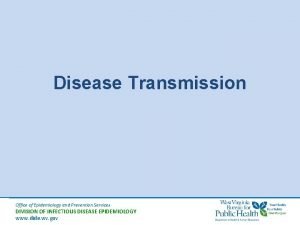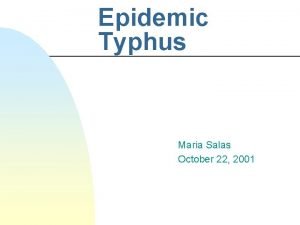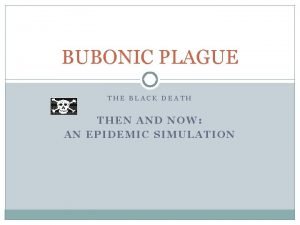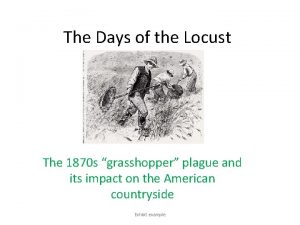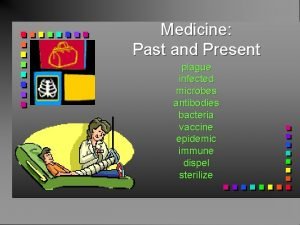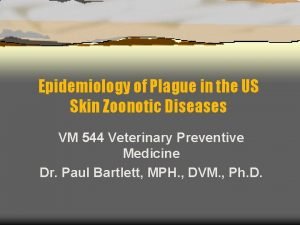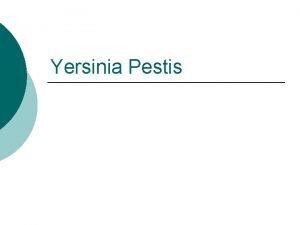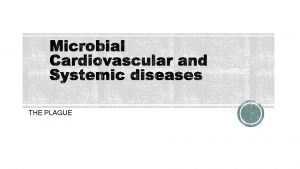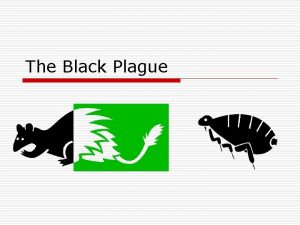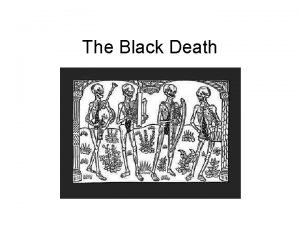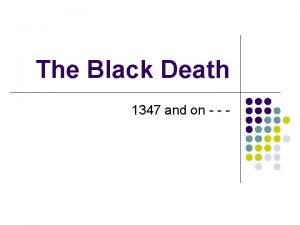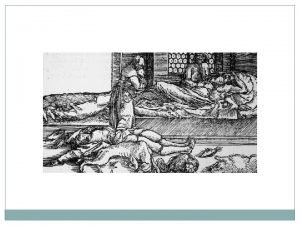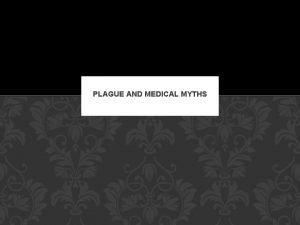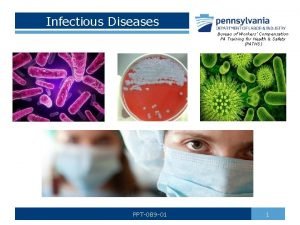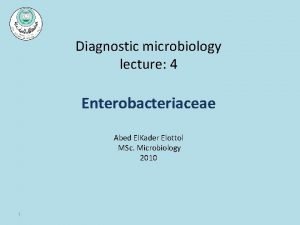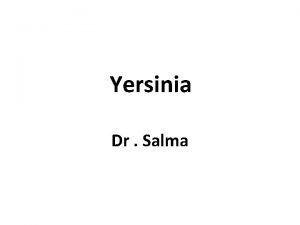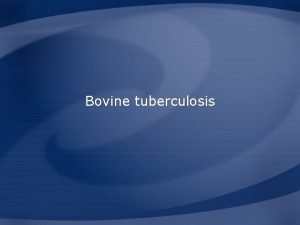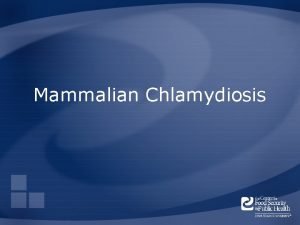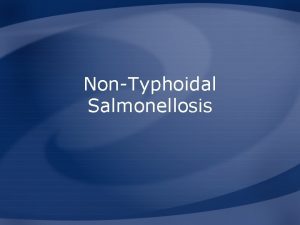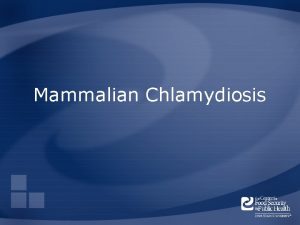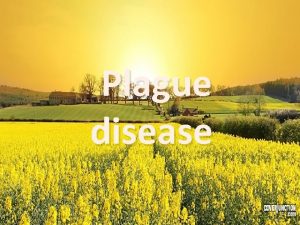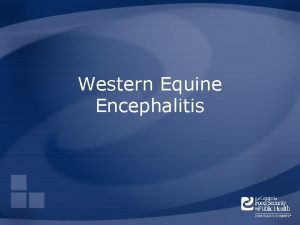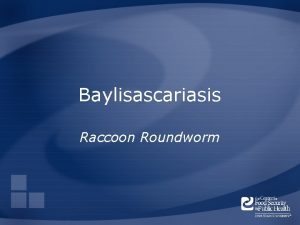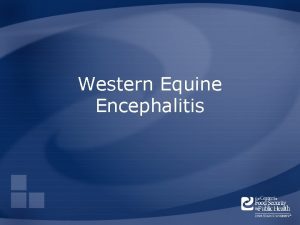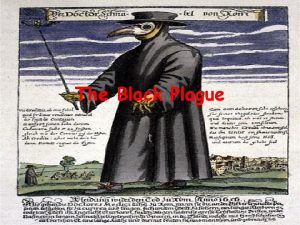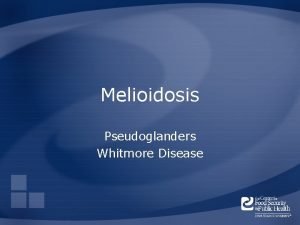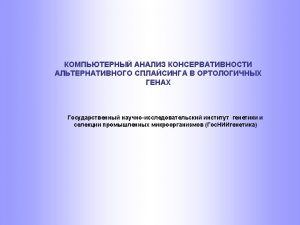Plague Overview Organism History Epidemiology Transmission Disease in





















































- Slides: 53

Plague

Overview • Organism • History • Epidemiology • Transmission • Disease in Humans • Disease in Animals • Prevention and Control Center for Food Security and Public Health, Iowa State University, 2011

The Organism

Yersinia pestis • Family Enterobacteriaceae – Gram negative – Pleomorphic coccobacillus – Aerobic, facultatively anaerobic, facultatively intracellular • One serotype – Three biovars • Multiple plasmids and virulence factors Center for Food Security and Public Health, Iowa State University, 2011

Yersinia pestis • Destroyed by – Sunlight – Desiccation • Survival – 1 hour in air – Briefly in soil – 1 week in soft tissue – Years when frozen Center for Food Security and Public Health, Iowa State University, 2011

History

History • 540 -590 AD: Justinian’s pandemic – 10, 000 deaths per day – Fall of the Roman Empire • 1346~1400: Black Death pandemic – Quarantine – 1/3 of European population died – Fall of the feudal system • 1665: Great Plague of London Center for Food Security and Public Health, Iowa State University, 2011

“Ring Around The Rosy A Pocket Full Of Posies Ashes, Ashes All Fall Down” Center for Food Security and Public Health, Iowa State University, 2011

Discovery • 1894: Hong Kong • Alexandre Yersin – Identified Gram negative bacillus • 1896 – Developed antiserum Center for Food Security and Public Health, Iowa State University, 2011

History: U. S. • 1899: Hawaii – From ship rats to sylvatic rodents – Spread throughout the western U. S. • 1924: Los Angeles – Last person-to-person case – 32 pneumonic cases; 31 deaths • Currently established in southwest Center for Food Security and Public Health, Iowa State University, 2011

Plague as a Disease • CDC Division of Quarantine • Reportable disease in the U. S. • All U. S. cases reported to the WHO Center for Food Security and Public Health, Iowa State University, 2011

Transmission

Transmission • Flea bite • Direct animal contact – Tissues, body fluids, scratches, bites – Enters through break in skin • Aerosol • Human cases – April through November – Increased activity of fleas and hosts Center for Food Security and Public Health, Iowa State University, 2011

Flea Vectors • Can live off host for months • Many species can serve as vector • Oropsylla montana – Rock squirrels, California ground squirrels, prairie dogs – Most important flea vector in U. S. • Xenopsylla cheopis – Epidemics in Asia, Africa, South America Center for Food Security and Public Health, Iowa State University, 2011

Flea Transmission • 27°C (80°F) – Blood clots in gut of flea – Y. pestis trapped – Clotted blood regurgitated – Enters wound from flea bite • 27°C – Blood clot in gut of flea dissolves – Y. pestis passes through Center for Food Security and Public Health, Iowa State University, 2011

Epidemiology

Distribution: U. S. • Southwest (87%) – Northern New Mexico – Southern Colorado – Northern Arizona – California • 1925 -1964 – ~2 cases/yr • Since 1970 – ~13 cases/yr Center for Food Security and Public Health, Iowa State University, 2011

Distribution: U. S. 45 40 Reported Cases 35 30 25 20 15 10 5 0 1972 1977 1982 1987 1992 1997 2002 Year MMWR Center for Food Security and Public Health, Iowa State University, 2011

Center for Food Security and Public Health, Iowa State University, 2011

Disease Cycles • Sylvatic (wild) • Urban (domestic) • Reservoirs – Rock squirrels – Ground squirrels – Prairie dogs – Mice, voles – Others Dr. Lloyd Glenn Ingles © California Academy of Sciences Center for Food Security and Public Health, Iowa State University, 2011

Sylvatic Plague • Enzootic – Steady level of disease – Low rodent mortality • Epizootic – Increased rodent mortality – Fleas seek out new hosts – Expansion into human occupied areas – Greatest threat to humans Center for Food Security and Public Health, Iowa State University, 2011

Urban Plague • Infected fleas or rodents move into urban areas • Domestic rodents infected – High rodent mortality • Fleas seek new host – Domestic cats or humans • Associated with poverty in humans Center for Food Security and Public Health, Iowa State University, 2011

Robert B. Crave. Plague. Infectious Diseases, 5 th ed. J. B. Lippincott Co. 1994. Center for Food Security and Public Health, Iowa State University, 2011

Disease in Humans

Human Disease • Three major forms of plague – Bubonic – Septicemic – Pneumonic • Primary • Secondary Center for Food Security and Public Health, Iowa State University, 2011

Bubonic Plague • Most common form – ~80% of cases • Incubation – 2 to 6 days • Clinical signs – Fever, malaise, chills, headache – Bubo: swollen, painful lymph node • Mortality (untreated): 50 -60% Center for Food Security and Public Health, Iowa State University, 2011

Septicemic Plague • Primary or secondary • Rapid onset • Clinical signs – Signs of sepsis ± bubo – Necrosis of extremities • Microthrombi block capillaries • “Black Death” • Mortality (untreated): 100% Center for Food Security and Public Health, Iowa State University, 2011

Pneumonic Plague • Incubation: 1 to 6 days • Primary—Y. pestis inhaled • Secondary—septicemic form spreads • Clinical signs – Fever, chills, headache, septicemia – Respiratory distress, hemoptysis • Person-to-person possible • Potential use as bioweapon Center for Food Security and Public Health, Iowa State University, 2011

Diagnosis • Identification of organism • Serology • Isolation of organism • Differential diagnoses – Tularemia – Hantavirus – Streptococcus – Staphylococcus aureus Center for Food Security and Public Health, Iowa State University, 2011

Treatment • Early treatment, survival ~100% • Supportive care • Antibiotics – Aminoglycosides – Doxycycline, tetracycline, chloramphenicol – Penicillins and cephalosporins are NOT effective Center for Food Security and Public Health, Iowa State University, 2011

Case Report • New York, 2002 – Married couple from New Mexico – Fever, unilateral inguinal adenopathy – Bubonic plague diagnosed – Antibiotic treatment – Deteriorated (septicemic spread) – Sent to ICU – Recovered after 6 weeks Center for Food Security and Public Health, Iowa State University, 2011

Case Report: Importance • NMDPH and CDC investigation – Trapped rodents and fleas around home – Y. pestis isolated • Importance – Plague outside of endemic area • Should raise suspicion – Prompt detection important Center for Food Security and Public Health, Iowa State University, 2011

Disease in Animals

Animals • Host species – Rodents, lagomorphs – No clinical signs • Other mammals – Most infections incidental • Felids very susceptible – Housecats – Wild cats • Ungulates, canids – Occasional infections reported Center for Food Security and Public Health, Iowa State University, 2011

Animal Sources of Human Infection in the U. S. 1970 -1993 N=319 Center for Food Security and Public Health, Iowa State University, 2011

Carnivore Source of Human Plague Infection, 1970 -98 Center for Food Security and Public Health, Iowa State University, 2011

Cats and Plague • Human cases from cats unknown prior to 1977 • By 1998 – 23 cases; 5 fatal • Cats develop severe illness and die • Can transfer disease to humans – Owners, veterinarians or staff – Pneumonic, fleas, bite, scratch Center for Food Security and Public Health, Iowa State University, 2011

Cats and Plague • Clinical signs – Severe illness – Signs mimic human illness – Bubonic, septicemic, pneumonic – Fever, lethargy, anorexia – Lymphadenopathy • Submandibular, cervical, others – DIC, death Center for Food Security and Public Health, Iowa State University, 2011

Cats and Plague: Experimental Infection • 16 cats – Each fed a plague infected mouse – All showed illness by day 3 -4 – Lymphadenopathy by days 4 -6 • 6 cats died (37. 5%) • 75% – Blood culture positive – Culture positive throat/oral cavity Center for Food Security and Public Health, Iowa State University, 2011

Case Report: Cat to Human • New Mexico, 1977 – 6 yr. old boy • September 6 – Fever, chills, vomiting, bilateral axillary pain – Insect bites & scratches on arms – Hospitalized with delirium • September 8 – Needle aspirate of lymph node • Positive on staining and FA for plague – IV antibiotics Center for Food Security and Public Health, Iowa State University, 2011

Case Report: Cat to Human • Improved, fever continued for 8 days • Buboes incised & drained on day 13 • Released on day 16 • History – Grandfather shot rabbits • Fed to cats and dogs – Boy took one cat home • Bit and scratched him • Cat later died of plague Center for Food Security and Public Health, Iowa State University, 2011

Dogs and Plague • Rarely show signs – Fever, lethargy, oral lesions, lymph node lesions • May seroconvert • May carry infected fleas • Diagnosis and treatment – Same as cats • Sentinels Center for Food Security and Public Health, Iowa State University, 2011

Diagnosis • Contact state public health laboratory or CDC before sampling • Diagnosis – Identification of organism – Serology – Isolation of organism • Treatment – Aminoglycosides, tetracyclines Center for Food Security and Public Health, Iowa State University, 2011

Prevention and Control

Prevention and Control • Isolate infected animals – Limit number of people in contact – Personal protection • Surgical mask, gloves, eye protection • Flea control – Dogs and cats • Spring to fall – Environment Center for Food Security and Public Health, Iowa State University, 2011

Prevention and Control • Prevent roaming or hunting of pets • Rodent control – Eliminate rodent habitat around home • Brush, food sources, firewood, junk – Undertaken only after insecticide use • Insect repellents for skin & clothes • Insecticide use in epizootic areas Center for Food Security and Public Health, Iowa State University, 2011

Center for Food Security and Public Health, Iowa State University, 2011

Prevention and Control • Public health education • Prophylactic antibiotics – Plague outbreak/flea bites – Handled infected animal – Close contact with plague case • Vaccine – Live and killed developed – No longer available in the U. S. Center for Food Security and Public Health, Iowa State University, 2011

Prevention and Awareness • Report suspected animal cases – State health department – State veterinarian – Animals may serve as sentinels • Education of clients and public – Risks, transmission, prevention • Take precautions in enzootic and epizootic areas Center for Food Security and Public Health, Iowa State University, 2011

Plague as a Biological Weapon • 1970 WHO estimate – 50 kg agent on city of 5 million • 150, 000 pneumonic cases – 36, 000 deaths • 80, 000 to 100, 000 hospitalized • 500, 000 secondary cases – Up to 100, 000 deaths total Center for Food Security and Public Health, Iowa State University, 2011

Additional Resources • World Organization for Animal Health (OIE) – www. oie. int • U. S. Department of Agriculture (USDA) – www. aphis. usda. gov • Center for Food Security and Public Health – www. cfsph. iastate. edu • USAHA Foreign Animal Diseases (“The Gray Book”) – www. usaha. org/pubs/fad. pdf Center for Food Security and Public Health, Iowa State University, 2011

Additional Resources • CDC - Division of Vector-borne Infectious Diseases – www. cdc. gov/ncidod/dvbid/index. htm • CDC - Plague information – www. bt. cdc. gov/agent/plague/index. asp Center for Food Security and Public Health, Iowa State University, 2011

Acknowledgments Development of this presentation was funded by grants from the Centers for Disease Control and Prevention, the Iowa Homeland Security and Emergency Management Division, and the Iowa Department of Agriculture and Land Stewardship to the Center for Food Security and Public Health at Iowa State University. Authors: Radford Davis, DVM, MPH; Glenda Dvorak, DVM, MS, MPH, DACVPM Reviewers: Nichollette Rider, MS; Jean Gladon, BS; Kerry Leedom Larson, DVM, MPH, Ph. D Center for Food Security and Public Health, Iowa State University, 2011
 Why does organism eat another organism
Why does organism eat another organism Infectivity definition
Infectivity definition Chapter 19 disease transmission and infection prevention
Chapter 19 disease transmission and infection prevention Chapter 19 disease transmission and infection prevention
Chapter 19 disease transmission and infection prevention Chapter 19 disease transmission and infection prevention
Chapter 19 disease transmission and infection prevention Disease transmission
Disease transmission Factors that influence disease transmission
Factors that influence disease transmission Disease transmission
Disease transmission Communicable disease and non communicable disease
Communicable disease and non communicable disease Exodus 7-11
Exodus 7-11 Litany in the time of plague
Litany in the time of plague How did the combination of plague upheaval in the church
How did the combination of plague upheaval in the church Ring around the rosie plague inc
Ring around the rosie plague inc Racism in othello act 4
Racism in othello act 4 Plague athens
Plague athens Black plague simulation
Black plague simulation 1870 locust plague
1870 locust plague Plague doctor walk rs3
Plague doctor walk rs3 Black death day
Black death day Plague info
Plague info Plague context clues
Plague context clues Srta ventisca
Srta ventisca Plague
Plague Stalactite growth yersinia
Stalactite growth yersinia Bubonic plague symptoms
Bubonic plague symptoms Spread of bubonic plague
Spread of bubonic plague Black rat plague
Black rat plague Flagellants definition black death
Flagellants definition black death Define bubonic plague
Define bubonic plague Plague
Plague Septicemic plague
Septicemic plague Septicemic plague
Septicemic plague Bubonic plague
Bubonic plague Plague doctor 1665
Plague doctor 1665 How did the plague make life harder for jews in europe?
How did the plague make life harder for jews in europe? Ukuran asosiasi adalah
Ukuran asosiasi adalah Nutrition epidemiology definition
Nutrition epidemiology definition Logistic regression epidemiology
Logistic regression epidemiology Prevalence calculation formula
Prevalence calculation formula Cross sectional study advantages and disadvantages
Cross sectional study advantages and disadvantages Attack rate calculation
Attack rate calculation Difference between descriptive and analytic epidemiology
Difference between descriptive and analytic epidemiology Person place time epidemiology
Person place time epidemiology Difference between descriptive and analytical epidemiology
Difference between descriptive and analytical epidemiology Descriptive vs analytical epidemiology
Descriptive vs analytical epidemiology Bibliography of epidemiology
Bibliography of epidemiology Association and causation
Association and causation Attack rate epidemiology formula
Attack rate epidemiology formula Ramboman acronym
Ramboman acronym Wheel model in epidemiology
Wheel model in epidemiology Epidemiology defination
Epidemiology defination Defination of epidemiology
Defination of epidemiology Distribution in epidemiology
Distribution in epidemiology What is descriptive study in epidemiology
What is descriptive study in epidemiology

